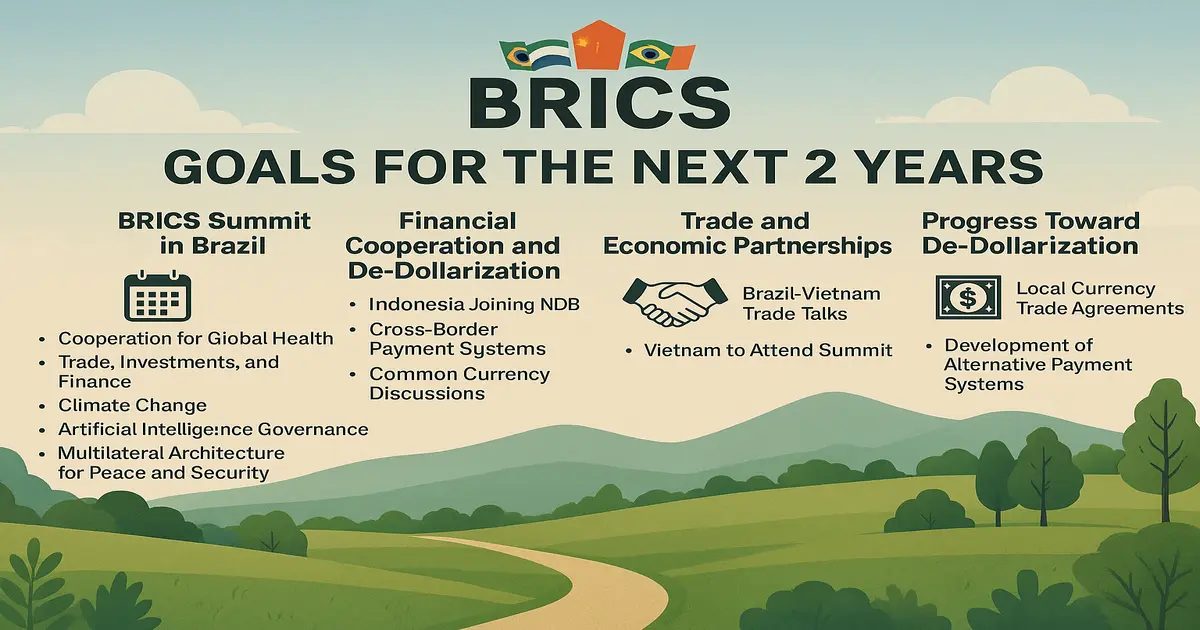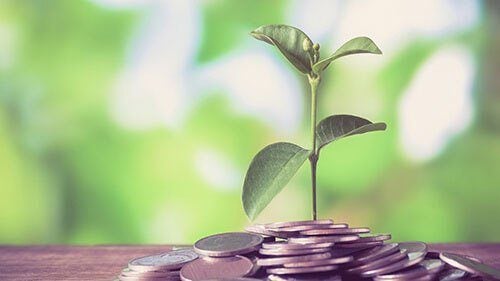What has BRICS planned in the next 24 months and what are it’s goals?
BRICS, originally comprising Brazil, Russia, India, China, and South Africa, has recently expanded to include Egypt, Ethiopia,
Iran, Saudi Arabia, and the United Arab Emirates (UAE). This expansion reflects the bloc’s ambition to enhance its influence in global affairs.
Upcoming Initiatives and Goals:
- 2025 BRICS Summit in Brazil: Scheduled for July 2025 in Brasília, this summit will address six key priorities:
- Cooperation for Global Health
- Trade, Investments, and Finance
- Climate Change
- Artificial Intelligence Governance
- Multilateral Architecture for Peace and Security
- Strengthening the Institutional Framework of BRICS
- Financial Cooperation and De-Dollarization Efforts:
- New Development Bank (NDB): Indonesia has announced its intention to join the NDB, aiming to support its economic transformation through investments in sectors like renewable energy and technological development.
- Cross-Border Payment Systems: BRICS nations are developing BRICS Pay, a decentralised payment messaging system designed to facilitate transactions in local currencies, reducing reliance on traditional systems like SWIFT.
- Common Currency Discussions: The bloc is exploring the feasibility of creating a common reserve currency backed by a basket of member currencies. While this initiative aims to enhance financial sovereignty, significant challenges remain due to the economic diversity among member nations.
- Trade and Economic Partnerships:
- Brazil and Vietnam are in discussions to enhance trade ties, including potential deals involving Embraer planes and Brazilian meat-processing operations in Vietnam. Additionally, Vietnam has been invited to participate in the upcoming BRICS summit in Brazil.
Progress Toward De-Dollarisation:
BRICS countries have initiated several measures to reduce dependence on the US dollar in international trade:
- Local Currency Trade Agreements: China and Brazil have agreed to conduct trade using their respective currencies, bypassing the US dollar.
- Development of Alternative Payment Systems: The BRICS Pay system and discussions around a common currency underscore the bloc’s commitment to creating financial infrastructures independent of the dollar.
Despite these efforts, the US dollar continues to dominate global trade and finance.
The success of de-dollarisation initiatives depends on overcoming significant economic and political challenges, including achieving consensus among diverse member economies and building robust financial infrastructures.
In summary, over the next 24 months, BRICS aims to strengthen internal cooperation across various sectors, expand its global influence through strategic partnerships and financial initiatives, and advance efforts toward financial independence from the US dollar.
BRICS, comprising Brazil, Russia, India, China, and South Africa, represent a significant portion of the global economy and population. Below are key statistics highlighting the bloc’s economic and demographic influence:
Population and Landmass:
- Population: As of 2023, BRICS countries collectively have a population exceeding 3.3 billion people, accounting for approximately 42% of the world’s total population.
- Landmass: The combined area of BRICS nations covers about 25% of the world’s total land area.
Economic Indicators:
- Gross Domestic Product (GDP):
- Nominal GDP: In 2024, the combined nominal GDP of BRICS countries is approximately $26.7 trillion, representing about 27% of the global GDP.
- GDP at Purchasing Power Parity (PPP): The collective GDP (PPP) is around $51.6 trillion, accounting for 35% of the global GDP (PPP).
- GDP Growth Rate: BRICS nations have experienced growth rates ranging from 4% to 5%, outpacing the G7 countries, which have growth rates between 1.5% and 2%.
Trade and Investment:
- Intra-BRICS Trade: As of 2022, trade among BRICS countries totalled approximately $614.8 billion.
- Foreign Direct Investment (FDI): In 2020, the United States and the United Kingdom were the top investors in BRICS countries in terms of FDI stock.
Currency and De-Dollarisation Efforts:
- Use of Local Currencies: BRICS nations are increasingly conducting trade in their local currencies to reduce reliance on the US dollar. For instance, China and Brazil finalised an agreement in March 2023 to conduct trade using their respective currencies.
- Reserve Holdings: BRICS+ countries control 42% of global central bank foreign exchange reserves, with gold comprising about 10% of their central bank reserves, half the global average.
Unemployment and Labor Force:
- Unemployment Rate: In 2023, the unemployment rate across BRICS countries stands at 5.3%, totalling approximately 84.7 million people.
- Labor Force Participation: As of 2024, the labour force participation rate in BRICS countries is 60.8%, with an informality rate of 62%.
Digital Economy and Technology:
- Internet Users: BRICS countries account for 40% of global internet users.
- Digital Payments: In 2022, over 87% of Russians used digital payments, followed by 86% in China, 81% in South Africa, 77% in Brazil, and 35% in India.
These statistics underscore the substantial role BRICS nations play in the global economy and their ongoing efforts to enhance economic cooperation and reduce dependency on traditional financial systems dominated by the US dollar.
Frequently Asked Questions FAQ about BRICS
What is BRICS?
BRICS is a geopolitical bloc originally formed by Brazil, Russia, India, China, and South Africa to promote peace, development, and economic cooperation among major emerging economies.
Who are the new members of BRICS?
As of 2024, BRICS expanded to include:
- Egypt
- Ethiopia
- Iran
- Saudi Arabia
- United Arab Emirates (UAE)
These countries joined to foster multipolar cooperation and reduce reliance on Western-dominated institutions.
What are BRICS’ key goals for the next 24 months?
BRICS is focused on:
- Enhancing trade in local currencies
- Launching BRICS Pay, a payment system alternative to SWIFT
- Expanding the New Development Bank (NDB) with new members like Indonesia
- Promoting sustainable development, AI governance, and climate action
- Advancing global health cooperation
- Strengthening its institutional structure
What is BRICS doing about de-dollarisation?
BRICS aims to reduce dependence on the US dollar by:
- Promoting bilateral trade in local currencies (e.g., yuan-ruble, yuan-real)
- Developing a common reserve currency (still in exploratory stages)
- Creating alternative financial messaging systems (e.g., BRICS Pay)
- Encouraging gold and local currency reserves
Is a BRICS currency being launched?
Not yet. A common BRICS currency is under discussion, but complexities due to economic disparities make it a long-term project.
How influential is BRICS globally?
- 42% of the global population
- Over 27% of global nominal GDP
- 35% of global GDP at PPP
- Controls 42% of global FX reserves
- Dominates in sectors like energy, commodities, and manufacturing
What is the New Development Bank (NDB)?
The NDB is BRICS’ multilateral financial institution based in Shanghai. It funds:
- Infrastructure projects
- Renewable energy
- Sustainable development in BRICS and other emerging economies
How does BRICS compare to G7 or G20?
While G7 represents developed economies, BRICS represents a counterbalance of emerging powers, aiming for more equitable global governance and financial reform.
What sectors are BRICS focusing on?
- Infrastructure & Energy
- Digital Economy & AI
- Healthcare & Pharmaceuticals
- Climate Adaptation & Green Technology
How can countries join BRICS?
New members are invited by consensus among existing members. A formal application process is still being debated for future expansion.
The British Landlords Association is a national landlord association for UK landlords and one of the largest landlord associations in the UK. The BLA is the only commercial landlords association in the UK. Join us now for £79.95!
Our top read blogs:
Is Commercial Property a Good Investment in England & Wales?
Commercial Property Rent Review Protocol
Investing in Commercial Property vs Residential Property: The Advantages and Disadvantages
Disclaimer:
This post is for general use only and is not intended to offer legal, tax, or investment advice; it may be out of date, incorrect, or maybe a guest post. You are required to seek legal advice from a solicitor before acting on anything written hereinabove.





